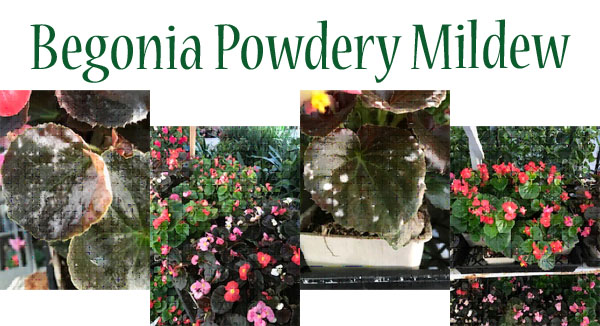Newsletter Articles
Begonia Powdery Mildew
By Richard Flowers, ACCNP-Green Thumb Nursery-Ventura
Begonias are one of the most popular plants around. They provide outstanding flower or foliage color for a shade loving garden. These perennials are excellent in containers, hanging baskets or in the ground used in borders and mass plantings. Many gardeners alike get frustrated when they see their beautiful Begonia plants develop an unsightly grey or white growth covering the leaves, stems, and flowers. The condition is known as Powdery Mildew. The typical symptoms Begonias exhibit are grey powdery spots or blotches that first appear on older or upper surfaces of the leaves. Tissue under the powdery growth may turn yellow or brown. Sometimes such leaves drop from the plant. Below I will provide you some tips you may want to consider to help reduce or sometimes prevent Mildew on your favorite plants, but have no fear, usually Powdery Mildew does not kill older plants because most Mildews can only survive in living plant tissue, however younger plants are more susceptible. First, I will provide you some basic growing conditions in which Begonias need to thrive.
Begonias prefer a fast draining soil, an open area with filtered light preferably an eastern exposure, (with the exception of dark- leafed Bedding Begonias which can tolerate more sun), consistent but light feeding, and enough water to keep them moist but not soggy. In areas where the summers are hot and dry, grow them in containers and place them in pebble lined saucers and keep the trays filled with water to below pot level. Begonias grown indoors need plenty of ambient light and keep them out of hot afternoon sun during the summer. Avoid sprinkling the leaves with water (overhead watering) whether growing indoor or out.
Taking each one of the above requirements and stressing the importance of them is critical in understanding how to limit or possibly avoid getting Mildew on your Begonias. Begonias need good, bright filtered light (not dim light) with an eastern exposure(this is usually an area with cooler morning sun location). If the amount of light is deficient your chances of getting Mildew are more likely. When fertilizing, fertilize lightly and consistently so your plant will grow more vigorously and stronger therefore less likely to contract the fungus. Do not apply nitrogen fertilizer in late summer, doing so will create lush succulent tissues that is attractive to this pathogen, instead I recommend fertilizing with a half strength solution of a liquid fertilizer with an NPK of 8-12-4 or something similar every other week to once a month, that way you will get good flowering, fine looking plants, and healthy specimens. When watering Begonias, do so with care and precision. (Make sure to get the soil wet and if at all possible do not to get the leaves wet because the moist leaves encourages the development of the fungus that causes Powdery Mildew) . Another strategy for watering, is using the pebble lined tray technique (as described above) this strategy will eliminate overhead watering.This trick is also excellent to employ anytime during the year. Also when watering your plants, be sure to water consistently and thoroughly. Begonias in dry soil are more susceptible to Mildew, likewise Begonias planted in damp, very shaded areas also attract this pathogen. Powdery Mildew is more problematic in a cool coastal zone, while warmer areas have less of an issue. This fungus is more prevalent during late summer and fall under humid or dry conditions. It is wise to keep plants away from cool air drafts and if grown indoors, the temperature should be as even as possible. Begonias love good air circulation, therefore it is best to not crowd plants together. Poor air circulation amongst plants equals more humidity which results in Mildew formation. If the plants are grown in pots space them further apart. If they are grown indoors, run a fan near the plants or open a window. On taller / bushier types of Begonias prune dense stems by cutting them back to above healthy sets of leaves to increase air circulation inside the plant.
Now you known how to keep your Begonia thriving in the garden and how to possibly prevent or lessen Powdery Mildew. Let’s now explore what to do once you have this fungus. Once you have Powdery Mildew, it is important to understand that the fungus will spread by splashing water and wind. If practical, pick off diseased leaves and discard the pieces. If plants are severely affected it may be necessary to remove and destroy those plants. If you see any leaves on the ground that look like Mildew, I advise you to remove the debris and throw it away in the garbage. By doing so you are helping to break the life cycle thus reducing the spread to other healthy Begonias. When preforming any pruning or clean up with Mildew infected plants, it is recommended to disinfect your tools. An easy and convenient way to do this is to use Clorox Disinfecting Wipes and simply wipe your tools clean. The best control for Powder Mildew is to limit and /or prevent it by the methods detailed above. If you must use a fungicide, some appropriate ones to use for Powdery Mildew include sulfur, Neem Oil (which is organic), Triforine or Potassium Bicarbonate applied every 7 to 14 days. When using any fungicide, it is best to read, follow, and understand all printed documentation the fungicide label has before applying the chemical. If you are unsure whether or not you have Powdery Mildew or something else that might look like it, it is wise to bring in a fresh sample (in a sealed plastic bag) to your local Green Thumb Nursery and we will be happy to point you in the right direction.
Do you like what you see? Sign up for our weekly newsletter to get content like this every week!

